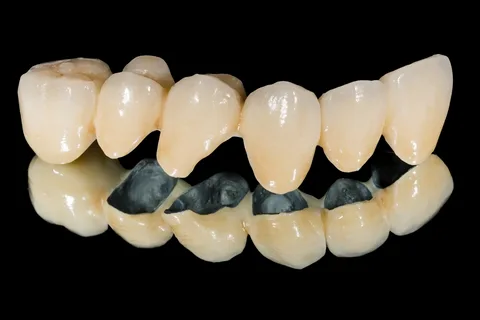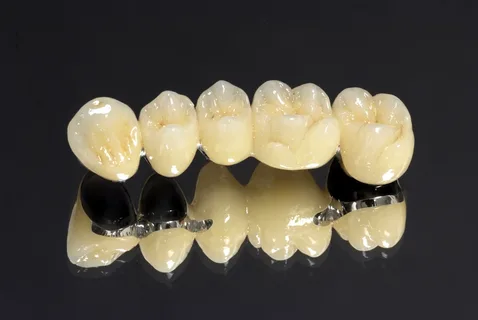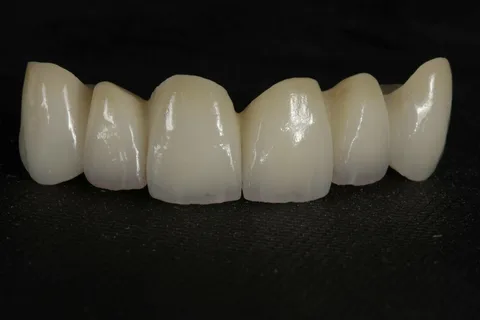Errors in the manufacture of metal-ceramic prostheses. Causes and prevention
Despite the fact that metal-ceramic prostheses today remain the most popular prostheses in orthopedic dentistry, which are made by a team of dental technicians every day, it is undeniable that their designs are imperfect, and errors during creation are very common.
Every year, the designs of bridges are improved, new auxiliary and structural materials are developed and introduced, the instrumental and technical arsenal of orthopedists and dental technicians is improved, the specialists themselves practice their skills through training courses and master classes, but mistakes still occur when creating metal-ceramic prostheses in the work of almost any specialist.
Learn more about the creation of metal-ceramic structures in the webinar Analog and digital laboratory protocols of metal ceramic restoration in the vertical preparation technique.

Rice. 1. Ready-made metal-ceramic prosthesis.
The purpose of this article is to assess errors and complications at various stages of the technological process of creating metal-ceramic prostheses, systematize the causes of their occurrence, and consider ways to eliminate them.
All errors can be divided into the following groups:
clinical, their consideration is not the purpose of the article,
laboratory,
errors at the casting stage.
The most common mistakes at the laboratory stage:
when modeling the frame,
when casting the frame,
when applying and firing ceramic mass.
Errors in the process of creating a collapsible model
The pin is not installed correctly
Consequences: after cutting, the plaster die cannot be removed.
Prevention of errors: needle pins are installed in compliance with the mandatory check of parallelism in all planes.
Failure to comply with the rules for working with plaster
Consequences: obtaining a low-quality, fragile model.
Errors
Incorrect plaster mixing technique.
The use of liquid supergypsum significantly increases its shrinkage, resulting in narrow crowns.
Prevention of these errors:
Class IV gypsum should be mixed in a vacuum mixer.
Class IV gypsum is poured on a vibrating table.
Compliance with these conditions allows you to obtain a high-quality collapsible model that will have a homogeneous structure, without air bubbles, and with excellent strength characteristics.
The absence of retention devices causes a lack of fixation of the fixed segments of the prosthesis to each other after sawing the model.
Prevention: as soon as the plaster begins to “set,” retention devices are placed in the end and intermediate sections of the model, which ensure further fixation of non-removable segments in the base of the model.
The step of applying insulating liquid to sections of the collapsible model in the places of the fixing pins was skipped . The error leads to the fact that the plaster die does not separate from the base of the model.
Prevention: Class IV gypsum, after curing, is coated with an insulating liquid in the area of the pins, so that plaster of different classes can be separated from each other and the die can be easily removed from the model.
Failure to follow the cutting technique into segments of the working part causes loss of integrity of the model; the metal frame of the bridge cannot be manufactured on this model.
Prevention: cutting is carried out using special tools:
jigsaws and files of various sizes, lengths and thicknesses,
dental motor and diamond-coated cutting discs.
Errors during the application of compensation varnish
If the layer of compensation varnish is too thick, wide crowns will result.
If you use an excessively thin layer, the crowns will be narrow.
Errors in the process of modeling the wax frame of a metal-ceramic prosthesis
The supporting teeth are modeled with a small taper and there are undercuts.
The wax melting temperature is set incorrectly.
Lack of micrometer control.
Deformation of a wax blank due to modeling the intermediate part of the prosthesis from elastic, fusible, non-rigid wax.
You can remove the wax blank after installing the distribution feeder, not earlier.

Rice. 2. Wax modeling of a bridge.
Errors during casting stages
Shrinkage shell. Causes
The sprue pins are not the correct height or diameter. In the case of a thin long pin, the metal begins to crystallize in it, as a result the sprue attracts metal from the profit and casting.
Prevention: strict adherence to the parameters of the sprue, height no more than 5 mm, diameter in the front section no more than 2 mm, in the side - from 3-4 mm. The diameter of the wax wire for profit is from 6 mm.

Rice. 3. Cast frame of a metal-ceramic prosthesis.
Metal overheating
If the metal overheated, the latter continued to boil in the mold, its cooling and crystallization occurred unevenly, a shrinkage cavity will be revealed in the separation area, in the interdental spaces, which will cause a fracture of the structure when processing the frame. Prevention: careful monitoring of metal temperature.
Pearls, or “pearls” on the surface of a metal product - the cast surface is not smooth. Causes
The wetting agent is not completely removed from the surface.
The mixing of the investment material took place under conditions of insufficient or no vacuum.
Excessive casting temperature.
Prevention
After fixing the wax composition onto the sprue cone, it must be degreased with a special liquid so that the molding compound tightly and evenly covers the workpiece.
All types of molding masses are mixed in a vacuum mixer, then the mass after mixing will be homogeneous and will not contain air bubbles, this guarantees a clean surface of the metal product. The molding mass is poured into the flask on a vibrating table.
Foundry shrinkage
To eliminate casting shrinkage, it is necessary to use anti-shrinkage agents, in our case, compensation varnish.
When applying topcoat varnish, it is important to take into account that the metal shrinks most along the cutting edge and the perimeter of the chewing surface.
Prevention: the first layer is applied 2-3 mm below the neck of the tooth, the next layer is applied from the neck of the tooth to the entire surface of the stump. In case of a large gap between the teeth, another layer is applied along the cutting edge or the perimeter of the chewing surface; thanks to these manipulations, it is possible to compensate for casting and volumetric shrinkage.
Errors at the stages of ceramic application and their prevention
Compliance with the ceramic firing temperature recommended by the manufacturer. If the selected temperature is low, the ceramics will take on a milky tint and the surface will be uneven. If the ceramics is too transparent, the temperature is too high; normally it should shine.
Application and firing of opaque
If the correct temperature conditions are observed, the surface will be shiny after firing.

Rice. 4. Shiny surface of the finished prosthesis.
Cracks on the surface. Causes
Low CTE of the alloy, in order to prevent this error, it is important to check the compatibility of the alloy and ceramics.
High CTE of ceramics due to slow cooling or hardening.
Excessively thin frame wall thickness.
Cracks due to compressive stress. Causes
High CTE of the alloy. Slow cooling and hardening are required, it is necessary to study the recommendations of the mass manufacturer, and clarify the compatibility of ceramics and alloy.
The ceramics are rough, not shiny, and not baked in depth. Causes.
The holding time is insufficient.
If the holding time is correct, then you need to check the firing temperature.
The appearance of bubbles in ceramics. Causes
Contamination of the ceramic or metal surface due to the use of unsuitable grinding tools. Prevention: use tools recommended by the manufacturer for processing ceramics and metal.
Rolling of cavities on the surface of a metal structure due to the use of blunt cutters. Prevention: timely replacement of cutters, since blunt cutters roll the metal in the processing area, which leads to the formation of gas-filled voids.
An excessively thick layer of opaque paste that did not have time to dry during the pre-drying stage.
Air inclusions in the ceramic layer. Prevention: Thorough mixing of ceramics before application.

Rice. 5. Ready-made bridge.
The ceramic mass is milky, porous, opaque. Causes
The vacuum was turned on late. Prevention: vacuum activation should be set at the temperature rise stage.
Low vacuum level. Prevention: timely correction of the vacuum pump, checking the tightness of all connections.
Low firing temperature. Prevention: strict control of oven settings, following passport recommendations.
The preheat temperature is too high. Prevention: compliance with the preheating temperature regime.

